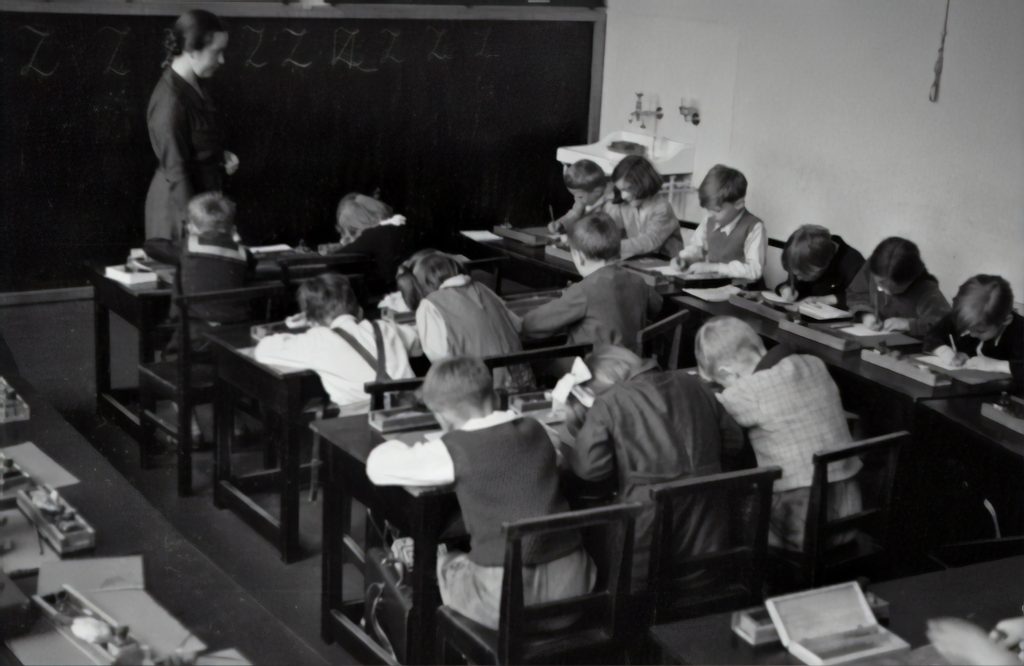Current schools cover Science, Technology, Engineering, Arts and Mathematics as separate subjects. However, growing evidence suggests that this style of teaching isn’t giving kids what they need. To address this, some schools have begun trying an integrated approach, called STEAM. STEAM education is meant to provide young people all the foundational knowledge they need. However, in its current format, STEAM education may not be enough for our modern world.
What is STEAM education?
Educators developed STEAM to differentiate discrete subjects under the umbrella term of science. Originally, the word “science” (from Latin “scientia”) meant knowledge. Of course, teaching young people the totality of human knowledge proved daunting. So, teachers organised human “knowledge” into specific areas. Science then became the systematic study of the universe, using logic and experiments to discover truth.
Education needs to give young people the skills to deal with modern global challenges. Professor Georgette Yakman and her team first proposed Science, Technology, Engineering and Mathematics (STEM) to meet this need. Later, educators added Arts to address underlying disconnects between the subjects of STEM. This became what we now call STEAM education.
The question remains whether this curriculum suits the needs of modern students. Further, teachers may not have the proper training to teach STEAM effectively.
What is the purpose of education?
One of the goals of education is to train a new generation of workers. However, this goal may be short-sighted in terms of producing a thriving society. The modern world is complex, and so needs people able to engage with it in multiple ways. Even from a purely business minded perspective, current educational programs aren’t enough. We are teaching our children skills suited to living in the past, not their future. For example, industries from the first and second industrial revolution are dying out. As a result, the demand for single-skilled workers, common to those industries, is rapidly diminishing.
So, we need to give children the tools to understand and engage with the world they live in. That is, critical thinking skills for the modern world. As such, the core goal of STEAM education is the comprehensive development of people. As Zhao (2010) says, education is a future-oriented business. Yet, the COVID-19 pandemic has highlighted a skills gap in the current workforce. This has forced companies to take a hard look at how to upskill and reskill employees.
“To face this challenge head-on, we need solutions that are nothing short of a skills revolution, not least because 85% of all jobs in 2030 have not been invented yet.”
Alain Dehaze, CEO of the Adecco Group
Why do 21st century students need different skills?
The modern era has seen rapid development of digital technologies. We are seeing new fields such as artificial intelligence, 3D printing, biotechnology and the ‘internet of things’. This has pushed business and universities to produce people with relevant training. Digital industries need workers with flexible skills to adapt to fluid working environments. However, technical skills are not enough. To flourish in a creative, problem-solving, collaborative workspace, we also need soft skills.
These include:
- Engagement
- Motivation
- Personalized learning experiences
Soft skill development also helps prepare people for dealing with the looming threat of climate change. The effects of the climate crisis on our world are complex and multi-faceted. Many problems are related to one another in ways that are not immediately obvious. For example, the Covid-19 pandemic has caused increases in domestic violence and child labour. To face such complex challenges, society increasingly needs more integrated and innovative citizens. Sustainable development needs breakthroughs and innovations in various technologies. So, human thinking and problem-solving methods will need to change.
The Design Literacy Research Group believes sustainable solutions need more than ‘professional’ designers. They think the general public should become ‘conscious’ consumers and decision makers. This shares the responsibility for quality and longevity of life. A concept often overlooked in a ‘throw-away’ society.
Clearly, the challenge of educating in the 21st century is a complex one. We need humanistic education that also meets sustainable needs and is functionally useful.

Is STEAM education working?
Currently, STEAM-related fields are redefining education globally. However, some argue that STEAM-based learning programmes lack definition and practical implementation. Do our teachers have the necessary training, knowledge, and experience? Teachers need appropriate background knowledge to teach tomorrow’s designers and engineers. Further, there needs to be enough trained teachers to meet demands. That said, STEAM teachers can develop innovative mindsets with the ability to problem-solve. This helps ensure that students become creators of technology, not just passive consumers.
The Australian Science Curriculum encourages scientific inquiry skills in students. It seeks to develop students as global citizens with cross-curriculum capabilities. It encourages students to adapt in a changing world and works towards unity in diversity. These goals may seem idealistic, but it is valuable to foster critical and creative thinking. Remember that today’s students are tomorrow’s citizens. We want students ‘to contribute to the creation of a more productive, sustainable and just society’ (ACARA, 2020).
What makes STEAM Education unique are the soft skills. It combines social and communication skills, character traits, attitudes and more. These enable people to navigate their environment and work well with others. However, it is equally important to not neglect hard skills. Finding the right measure of arts and humanities to incorporate into the sciences is thus difficult.
An additional weakness of STEAM is that it is heavily science focused. As such, it does not involve the arts to the same degree as the hard sciences. There appears no current method that incorporates everything as a unified way of education. In fact, achieving those goals requires teachers who possess the mixture of hard and soft skills our education system fails to teach.
What are the components of a STEAM Education?
Technology Literacy
Achieving technology literacy through STEAM, requires additional elements. These elements appear in Project Based Learning (PBL), a separate educational framework. These elements include technology, computer programming, and engineering. PBL on its own is useful but lacks key soft skills training. Combining STEAM with PBL thus provides a more holistic learning experience.
Currently, teachers use STEAM to supplement their existing curriculums. They also mostly do this after school hours, aka. 4:30pm. This does give students the opportunity to explore complex computer and technological tasks. But STEAM also requires students to experience real-world applications. PBL can offer this if the teachers themselves have the qualities and components of STEAM.
Computational Thinking
STEAM also includes an emphasis on building computational thinking skills. This helps students approach problems objectively and find solutions. Students are thus in a better position to understand coding languages. They can then go on to develop text-based or visual-based applications.
Critical Thinking
As a cross-curricular toolset, STEAM provides value to teaching in all subjects. Students who can think critically have an advantage in solving any problem. Particularly so if they need to use an approach that unifies two subject areas.

Collaboration On Tasks
STEAM learning requires students to work together to solve complex, real-world problems. These problems also give students a lot of creative latitude to solve these problems. Under teacher guidance, students agree upon the best way to solve problems.
Communication On Tasks
Communication is critical in both the classroom and the working world. To collaborate on tasks, students need to communicate effectively. Pearson defines collaboration as communicating with others, resolving conflicts, and managing tasks. Communication skills are thus necessary for the development of self-advocacy and self-determination. These are important skills for lifelong success.
Leadership
Employers often look for more than hard skills, experience, and training when hiring. They look for enthusiasm, upbeat attitudes, and cooperative manners. Being able to demonstrate these soft skills gives candidates an advantage over others.
Students benefit from finding ways to bring their passions to other subjects. It gives them confidence to engage and makes them appear like subject matter experts. Displaying confidence and leadership is important to solve real-world problems.
Social Skills
Social skills are critical for students as they develop into adults. The Collaborative for Academic, Social, and Emotional Learning found evidence for this. Their report found “students with social-emotional learning, scored 11 percentile points higher than students who did not receive this instruction”. Please note that this is an incredibly large difference. As such, it shows the power of being able to understand, empathize and communicate with others.
How does changing the education system help our future?
Our education system is obsolete. Educating students for industrial-age thinking only gives them skills for the past. Society has advanced past the need to structure the school year around a bygone farm or factory work era. We also need to re-examine the practice of advancing students on a fixed-time basis. The current curriculum-based approach is fundamentally not student-centric. Hence, we need to update our model to support the needs of students who will live within a digital economy.
Adaptation is key to overcoming the challenges the world faces. That means changing how we train and educate young people, to meet those challenges. As a society develops, it needs human resources to support it. So, to achieve the UN’s Sustainable Development Goals we need people with an interdisciplinary mindset. Integrating concepts from different subjects like science and technology can help do this. Some online schools are doing this already by revolutionising how education looks in the 21st century.

What is the future for Steam Education?
As yet, STEAM lacks robust support. Additionally, current use focuses more on the scientific branch of education. This is a serious flaw in a system designed to be holistic. Our digital society demands professionals trained in technological media and tools. Furthermore, the need for sustainable development adds another level of complexity to education. Thus, much more research needs to be done to make STEM/STEAM a mainstream pedagogy.
THRIVE aims to offer a well-rounded educational experience for all. Please support us by donating or volunteering your time. Help us produce a multi-literate citizenry and workforce for the 21st century.























